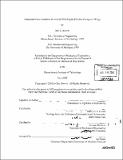Integrated strain actuation in aircraft with highly flexible composite wings
Author(s)
Brown, Eric L. (Eric Lee)
DownloadFull printable version (12.91Mb)
Other Contributors
Massachusetts Institute of Technology. Dept. of Mechanical Engineering.
Advisor
Carlos E.S. Cesnik.
Terms of use
Metadata
Show full item recordAbstract
The purpose of this thesis is to provide a framework for the study of wing warping as a means of achieving multiple aeroelastic goals. Shape change is achieved by integrating anisotropic piezoelectric composites (APC) within the passive composite wing skin. The goals include the ability of integrated strain actuation (ISA) to provide sufficient wing deformation for roll maneuver, gust load alleviation, flutter suppression, and redistribution of maneuver loads. A nonlinear analysis tool was constructed to study the behavior of aircraft with highly flexible active wings undergoing large deformation. It combines a new large displacement, strain-based finite element beam formulation with a finite-state unsteady aerodynamics model and a thin-wall active beam cross section model. The tool was created with the flexibility to model different aircraft configurations, including unconventional ones such as joined wing designs. The effects of sweep and dihedral, as well as large deformations are taken into account in the calculation of aerodynamic loads. The strain-based finite element formulation allows for a simplified control design because the flexible degrees of freedom are easily accessible by strain gages. To support the evaluation of ISA performance, and to study the impact of vehicle size on performance, three representative conventional vehicles using aileron control are modeled. The vehicles are based on fielded unmanned aerial vehicles (UAV), representing low, medium, and high altitude classes. The ISA wings are modeled by replacing some of the passive composite plies in with APC. The active and passive vehicles are compared based on the goals stated above. The impact of the piezoelectric composite material properties on weight and performance is discussed. (cont.) The required property values are determined for making ISA a viable method for primary roll control and wing stability. Numerical results show that roll control without ailerons is possible using present actuator technology. Integrated strain actuation is also shown to significantly alleviate gust loading and increase the flutter speed. Peak maneuver stresses are significantly reduced through active lift redistribution.
Description
Thesis (Sc. D.)--Massachusetts Institute of Technology, Dept. of Mechanical Engineering, 2003. Includes bibliographical references (p. 167-171).
Date issued
2003Department
Massachusetts Institute of Technology. Department of Mechanical EngineeringPublisher
Massachusetts Institute of Technology
Keywords
Mechanical Engineering.